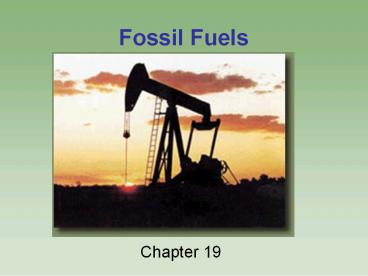Fossil Fuels PowerPoint PPT Presentation
1 / 25
Title: Fossil Fuels
1
Fossil Fuels
- Chapter 19
2
http//www.anwr.org/gallery/pages/03-ANWRtoUSmap.h
tm
3
1. Natural Gas
- What it is
- Mixture of methane (50-90), heavier hydrocarbons
(ethane, propane, butane) and small amounts of
H2S (highly toxic) - Properties
- Highly flammable transportation difficult. Done
in pipelines - Cleanest burning fossil fuel
- Methane is dried, cleansed of H2S, pumped in low
pressure lines nationally. - Heavier gases are removed as liquefied petroleum
gas (LPG) for use in rural areas.
4
Natural Gas Distribution
5
Hydraulic Fracturing
- How
- Pumping water chemicals under high pressure
underground to force natural gas/petroleum to
surface - Problems
- Possible groundwater contamination
- CH4 released
- Release of Fracking Chemicals
6
http//en.wikipedia.org/wiki/FileHydroFrac.png
7
How Long Will Natural Gas Last?
- At current consumption rate, factoring in
undiscovered reserves, approximately 125 years. - Including unconventional sources, 200-325 years
8
2. Coal
- What is it
- Solid fuel formed from plant matter during
Carboniferous period, 360-285 million years ago. - C content increases, water content decreases over
time - Ranked according to energy content
9
Type Energy Content (megajoules/kg) Location in US
1. Anthracite 30-34 PA
2. Bituminous 23-34 Appalachia, Midwest, West
3. Subbituminous 16-23 West
4. Lignite 13-16 Gulf Coast, No. Great Plains
10
- Half is acquired through Strip-Mining (Surface
Mining) - Acid Mine Drainage
- rainfall reacts with exposed rock, reacts with
sulfides, produces sulfuric acid. - Processed to remove much sulfur before burning
- Uses of Coal
- converted into synthetic oil or gas.
- Mostly used by power plants to create electricity
(60 of electricity produced). - Transported by train and coal slurry pipelines
(uses more water).
11
Open Pit Mining digging at the surface to
extract ore
12
Coal Surface Mining in Wyoming
http//en.wikipedia.org/wiki/Strip_miningStrip_mi
ning
13
Coal Mine in India
http//en.wikipedia.org/wiki/File182619562_00d6f7
03b6_b.jpg
14
(No Transcript)
15
Pollution Coal
- Burning releases mercury into env.
- Takes a great deal of water expensive, heavy
environmental impact - Production of NOx and SOx
- Particulate Ash
- Treatment--Scrubbing
- calcium carbonate-rich materials are injected
into the gases produced from burning coal,
producing hydrated calcium sulfite as sludge. - Disposal issues.
16
How Long Will Coal Last?
- At current consumption, 225 years. If usage
rises 2/yr, 65 years. - Believed to be unidentified reserves projected to
last 900 years.
17
3. OIL!
- Petroleum (crude oil)
- thick liquid consisting of hundreds of
combustible hydrocarbons. - Impurities
- sulfur, oxygen, nitrogen other impurities.
- Formation
- decomposition of organic matter (mostly plant)
- extreme pressures temperatures
- millions of years
- Usually dispersed throughout pores in rocks.
18
Oil Recover 3 Stage Process
- Primary
- Drilling a well, then remove oil that flows into
the well. - Secondary
- Pumping water under high pressure into a nearby
well, forcing oil out, pump up to surface, - remove water from oil and reuse the water for
recovery. - Tertiary
- Use of superheated steam, CO2 or detergent to
dissolve oil, then removed from that. - Large amounts of energy needed (1/3 barrel for
every barrel produced) - Production clip
19
Fractional Distillation
- Separating the components that make up crude oil.
- Uses boiling points of the various fractions
20
(No Transcript)
21
64 in the Middle East 26 in Saudi Arabia alone
22
(No Transcript)
23
Oil Facts
- US uses 30 of crude oil extracted 68 for
transportation - 130.00 per barrel on 6/6/08
- 48.92 per barrel 4/22/09
- 91.58 per barrel 4/25/13
- 1 barrel petroleum 42 gallons
24
Just How Much Is There?
- Resource
- A concentration of material that is economically
feasible to extract, now or in the future. - Reserve
- Portion of the resource that can be extracted
now, economically legally.
25
Reserves
- Production of reserves expected to peak between
2010 and 2030. Peaked in US in 1975. - Undiscovered supplies may extend it 20-40 years.
26
Other Sources of Oil
- Oil Shale fine-grained sedimentary rock
containing kerogen. - Distilled to form shale oil.
- Potentially recoverable from CO, UT, WY.
- Generally very low grade, takes much energy.
- Tar sand mixture of clay, sand, water bitumen
(thick, high sulfur oil). - Most lie below earths surface those close can
be mined. - Largest deposits in Canada, UT, Venezuela,
Colombia, Russia.
27
Hubberts Prediction for Peak Oil Production
http//en.wikipedia.org/wiki/FileHubbert_peak_oil
_plot.svg

